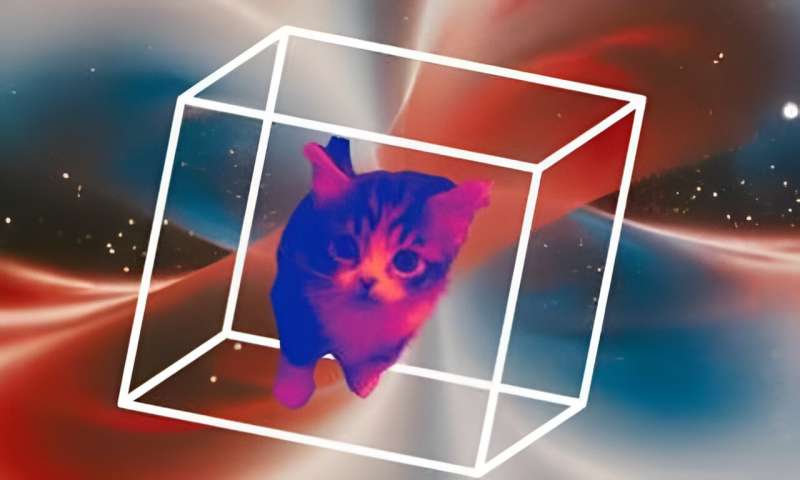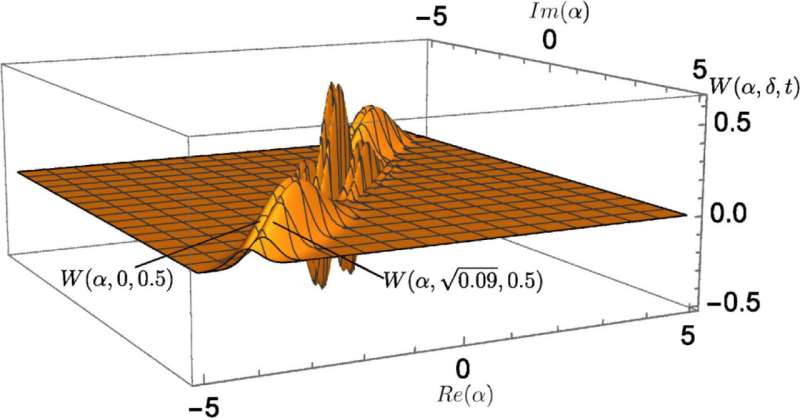
JUNE 17, 2024 by Robert Lea, SciencePOD
Collected at: https://phys.org/news/2024-06-schrdinger-cat-quantum-sensitivity.html
One of the most counter-intuitive aspects of quantum physics is the idea that a quantum system, unlike a physical system governed by the everyday physics of the macroscopic universe, can exist in two states at once even if these states are contradictory.
This is called a superposition, and the states are then described as overlapping waves. The superposition is resolved by constructive or destructive interference caused when the peaks and troughs of different waves meet and amplify or cancel each other, causing a single wave to emerge.
This is perfectly exemplified by the “Schrödinger’s cat” thought experiment, in which a hypothetical cat sealed from observers is both dead and alive until a measurement is made and the superposition collapses, causing a single state to resolve itself.
As wild as the concept of a superposition of contradictory states may sound, this principle and other forms of “quantum weirdness” are at the heart of a revolution in technology that includes quantum sensors, which use the fundamental properties of photons to make measurements, and quantum computers.
In quantum computers, for instance, the fundamental units of standard computers, “bits” are replaced with “quantum bits” or “qubits,” which can exist in a superposition of multiple contradictory states at once, i.e., a Schrödinger cat state.
A new paper published in Physics Open by Ranjit Singh, an independent researcher based in Moscow, Russia, and Alexander E. Teretenkov from the Steklov Mathematical Institute of the Russian Academy of Sciences details how the sensitivity of quantum technology can be improved by using Schrödinger cat states that are “squeezed” to compress the amount of noise — that is, random, unpredictable, and undesirable signals — affecting measurements.

“Squeezed Schrödinger cat states can potentially be used to identify small perturbations if they are coupled to the perturbation medium. Such a precession can be more advantageous compared to Schrödinger cat states without squeezing,” Singh says.
“Our theoretical research opens potential ways to increase the number of photons in the Schrödinger cat state, increase the quantum sensitivity, and preserve the interference present in the Schrödinger cat state by using optical parametric processing.”
He adds that it is difficult to increase the number of photons in the Schrödinger cat state, but he and Teretenkov found the mechanism of an optical parametric process that does just this. Singh explains that the parametric process used also preserves the interference parameters and “squeezes the noise” in a quantum system. Reducing the noise while upping the number of photons increases the quantum sensitivity.
“Research on the use of squeezed Schrödinger cat states is quite interesting. It has started to develop rapidly and is promising in many aspects of modern quantum physics and quantum technologies,” he adds. “Squeezed states are widely used in quantum optics, and Schrödinger cat states are now actively attracting the attention of scientists and technologists.”
This research doesn’t just have theoretical implications but can lead to specific applications in significant quantum technologies, in particular in quantum sensors. “Our research is at the intersection of important trends in modern quantum physics,” Singh concludes.
More information: Ranjit Singh et al, Quantum sensitivity of squeezed Schrodinger cat states, Physics Open (2023). DOI: 10.1016/j.physo.2023.100198

Leave a Reply